How Robust Is Your Game Plan?
We all have them; tendencies and behaviors that come naturally, and those that we know are best for us but always seem to take effort. And get deprioritized first, or simply forgotten, when under stress. Like eating an orange in the morning as I like to do. I know it’s healthy, and even enjoy it when I take the time – but starting my day these 5 precious minutes earlier, instead of taking the time to peel and eat my orange first, is always more enticing. Especially when I have deadlines or an early morning call. What’s your orange? And especially for (senior) leadership teams, what can you do to focus on what you know is
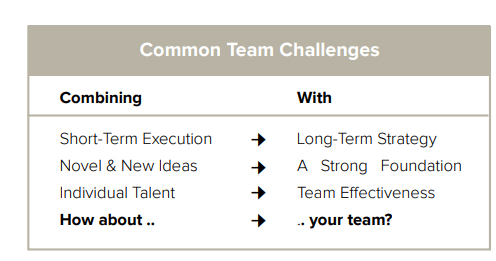 important – and your stakeholders are counting on you to do well – but may find difficult to prioritize when pressures take over?
important – and your stakeholders are counting on you to do well – but may find difficult to prioritize when pressures take over?
Every executive and every (senior) leadership team has a full plate of important topics that are all fighting for attention – and the list only seems to grow in the extraordinary times we live in.
The demands of 2022 will force any team to continually prioritize effectively, and balance their natural focus areas with topics they may overlook when under pressure.
1. Combining both the short-term/urgent with long-term value-creation

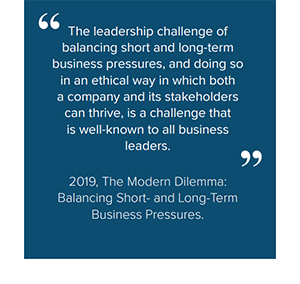 Effective teams have ‘one foot in today and one foot in tomorrow’. Yet senior teams suffering from a bias for action may end up de-prioritizing progress on their long-term agenda. Especially with the continued impacts and volatility of the pandemic; hybrid ways of working, global supply chain issues, shortage of talent and a growing number of vacancies… the list of urgent challenges can be relentless and even overwhelming.
Effective teams have ‘one foot in today and one foot in tomorrow’. Yet senior teams suffering from a bias for action may end up de-prioritizing progress on their long-term agenda. Especially with the continued impacts and volatility of the pandemic; hybrid ways of working, global supply chain issues, shortage of talent and a growing number of vacancies… the list of urgent challenges can be relentless and even overwhelming.
On top of that, the often quarterly pace of reporting results can create ‘short-termism’, next to the inevitable pressure to deliver more, at higher quality but with less resources (what Dr. Peter Hawkins calls the ‘Unholy Trinity’). Yet having only a ‘little toe in tomorrow’ may lead to an underdeveloped strategy, immature plans or delayed execution on long-term demands or market opportunities.
For example, the progress needed on Diversity/Equity/Inclusion, employee wellbeing and health, the environmental, social and governance (ESG) matters, and a move towards ‘good stewardship’ practices all take time and dedicated effort to mature and solidify in concrete plans and clear priorities. And the Future of Work is already among us, whether organizations are ready for its opportunities or not. The only question is whether you are ready enough and if you make significant progress in 2022.
Tomorrow’s opportunities are building on today’s choices – what does your team need to prioritize this year despite the inevitable urgencies on your plate?
2. Combining a focus on new and novel insights with a strong foundation

Keeping up with the latest trends and research is important to be ready for whatever the future holds – especially in light of long-term strategies and plans. There certainly is and always will be a place (and lucrative market) for inspirational sessions and speakers – but should never go at the expense of securing a strong foundation. Too often, a bias for new and novel replaces, not complements, the team’s focus and energy. A team will not grow beyond the strength or weakness of its foundation, much like the game plan for a sports team: fully-developed and customized for the unique group of players who depend on each other and are prepared and ready to deliver outstanding results together.
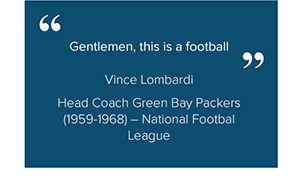 How disciplined is your team in securing a robust game plan for what 2022 has in store? A quick story from US sports (but even rest-of-the-world readers should relate as every sport has basic routines to perfect). “Gentlemen, this is a football.” These words were spoken at the start of a summer training camp in 1961 – not to a group of kids, but to world-class players who were playing (American) football at the highest level possible. Spoken by one of the greatest coaches in (American) football history, this statement typifies Vince Lombardi’s relentless focus on the fundamentals of the game – even when working with professionals who were celebrated as some of best pro-players of their lifetime.
How disciplined is your team in securing a robust game plan for what 2022 has in store? A quick story from US sports (but even rest-of-the-world readers should relate as every sport has basic routines to perfect). “Gentlemen, this is a football.” These words were spoken at the start of a summer training camp in 1961 – not to a group of kids, but to world-class players who were playing (American) football at the highest level possible. Spoken by one of the greatest coaches in (American) football history, this statement typifies Vince Lombardi’s relentless focus on the fundamentals of the game – even when working with professionals who were celebrated as some of best pro-players of their lifetime.
Regardless of the players’ experience, prestige and pride, he insisted on mastering the blocking, tackling, and perfecting the basic techniques – the small choices that players make every game, the daily habits and repeated actions that make or break the moments on the field that truly matter. For every leader: be Vince Lombardi for your team. Ensure all the basics are in place – no exceptions.
When teams have incomplete or even weak foundations, it’s a matter of time that they get tripped up and struggle. There is no short-cut for the effort it takes to form deep and trusting relationships (especially when working remote, virtual or hybrid), to explore, discuss and agree on the team’s unique purpose and mandate, that are fully anchored in their specific stakeholder landscape, and actually delivering their unique value through effective ways of working.
How ready is your team’s foundation for a new year of challenges, and what can you do to strengthen it further?
3. Combining a focus on individual talent with attention for team effectiveness

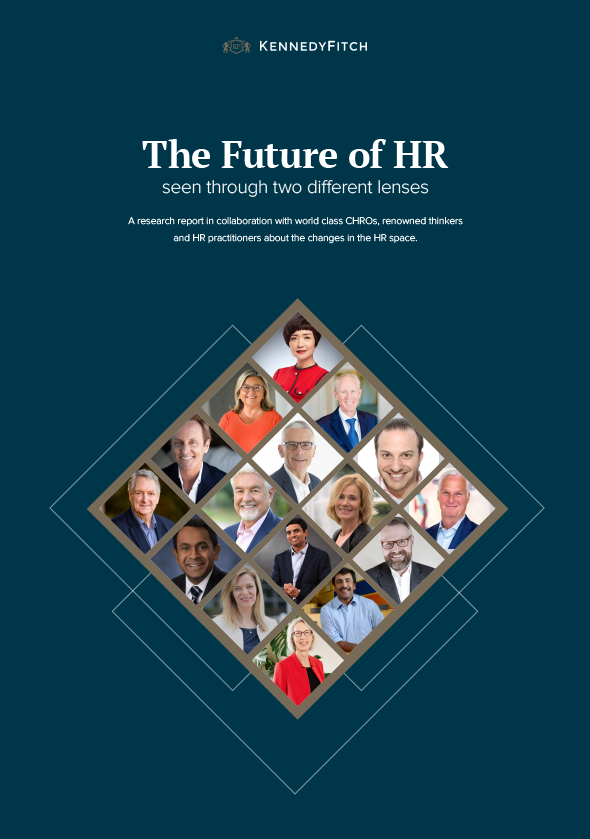 Senior teams face serious talent issues, impacted by the global war for talent and in some regions even a Great Resignation. KennedyFitch can certainly help with its world-class executive search practice for key leadership positions. At the same time, most business challenges and opportunities are multi-disciplinary in nature and require extensive collaboration between departments, leaders and experts. The 2021 KennedyFitch “Future of HR“ research report states that “teamwork will only increase as a significant trend in how work gets done” that calls for team-based organizational models with “systems that encourage participation and teach people to be better, effective team members”.
Senior teams face serious talent issues, impacted by the global war for talent and in some regions even a Great Resignation. KennedyFitch can certainly help with its world-class executive search practice for key leadership positions. At the same time, most business challenges and opportunities are multi-disciplinary in nature and require extensive collaboration between departments, leaders and experts. The 2021 KennedyFitch “Future of HR“ research report states that “teamwork will only increase as a significant trend in how work gets done” that calls for team-based organizational models with “systems that encourage participation and teach people to be better, effective team members”.
With all the focus in Talent processes (recruitment, training and development, promotion, rewards) on filling and developing individual talent, it’s increasingly important to invest in mature strategies how the work gets done by all the talent you attract, develop and seek to retain. Team Effectiveness strategies are needed to enable teams at all levels to deliver their best value and deliver maximum value through intensive and complex collaboration in teams. How is your team measuring its own effectiveness, its impact on your key stakeholders and dedication to reaching its full potential – beyond the focus on individual talent spotting and development?
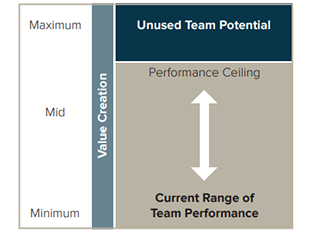 When working in Manhattan in one of midtown’s skyscrapers, I learned about ‘air rights’. The value of any skyscraper is not just the current structure that’s built on a particular lot, but also the maximum square footage that is allowed based on the zoning permits. In some cases, the current building structure doesn’t fully use the permissible zoning potential, and has additional ‘air rights’ that rise above its current structure. The difference between the actual building structure and the zoning potential is called ‘Unused Development Rights’. Effective teams combine a strong bias for action with the ability to ‘hit the pause button’ effectively to consider its current performance ceiling, and tap into their ‘Unused Team Potential’. Effective teams find ways to surface the dynamics and behavioral patterns that may get in the way and experiment with new ways to help the team tap into their unused team potential. Working in teams will become even more important going forward, and team effectiveness strategies should keep up.
When working in Manhattan in one of midtown’s skyscrapers, I learned about ‘air rights’. The value of any skyscraper is not just the current structure that’s built on a particular lot, but also the maximum square footage that is allowed based on the zoning permits. In some cases, the current building structure doesn’t fully use the permissible zoning potential, and has additional ‘air rights’ that rise above its current structure. The difference between the actual building structure and the zoning potential is called ‘Unused Development Rights’. Effective teams combine a strong bias for action with the ability to ‘hit the pause button’ effectively to consider its current performance ceiling, and tap into their ‘Unused Team Potential’. Effective teams find ways to surface the dynamics and behavioral patterns that may get in the way and experiment with new ways to help the team tap into their unused team potential. Working in teams will become even more important going forward, and team effectiveness strategies should keep up.
Next to your focus on securing top talent for key roles, how is your leadership team measuring and improving its impact together?
There are many more dimensions that you and your team may face, like harmony AND constructive challenge, or control AND empowering. Whatever they are, teams that are aware of their own dynamics and effectively navigate these are typically best in long-term value creation, credibility and impact, as well as team engagement and morale.
Here are some suggestions to boost your readiness for whatever your 2022 will bring – and staying on course together.
Suggestions at the Individual level
- Know your own tendencies as a senior leader, for your team is impacted by your strengths as well as your gaps. This will provide a strong basis for your own development as you help your team navigate the collective business agenda. A senior HR leader or an experienced executive coach who observes you in action can also provide valuable feedback, especially on blind spots and interactions with your team.
- Consider your own style and potential bias for the typical dimensions in this article, and add additional ones you believe your team will face in 2022. Discuss your assessment with your team as you discuss your business strategy and targets for the year – what will be critical for your 2022 plans and how will you keep yourselves on track? What role can/should you play in helping the team keep their eye on the ball?
- When you are a senior leader: be a sponsor and role model for team effectiveness in your senior leadership team and your department. Ask your direct reports to share their team diagnostic results and team development plans for 2022, in support of their targets and year plan. Ensure that all leaders in your organization have access to resources, tools, in-house training and expertise you believe will boost your team’s impact in 2022.
Suggestions at the Team level
Teams often struggle to prioritize or execute the below steps effectively by themselves and find great value in working with an in-house HR expert or an external team coach
- Analyze the strengths, natural styles and development areas on your team. Use a team diagnostic to perform a thorough check how you are delivering against your unique purpose and also surface the team’s strengths and gaps. Despite the available methods, many (even senior) leadership teams are not methodical yet in using diagnostics and meaningful metrics that measures and monitors the team’s effectiveness.
- Agree together what the non-negotiable priorities are, and revisit constantly when new information, new developments or new requests fill your team’s plate. Agree on a clear game plan for how the team will deliver its full value in 2022, which includes the team’s dynamics and tendencies to watch out for.
- Monitor and adjust the team’s game plan frequently. Just like monthly and quarterly reporting on business results, also review progress and barriers on living the team’s purpose and executing the game plan. What adjustments are needed, how is the team working together and what course-correction is needed?
Suggestions at the Organizational level
- Setting clear priorities at the organization and department/functional level, and revisiting frequently to confirm their validity, will give guidance for middle and frontline leaders. Too many priorities that may not be feasible will only force the hard job of prioritization downstream, to the middle and frontline leaders with finite capacity and real-world problems to tackle. The closer senior teams can come to the monitoring execution issues, and surface daily prioritizations that your leaders and teams need to make, the closer its impacts and strategic trade-offs can be managed.
- Review with the executive team, the HR leadership team and the Board if Team Effectiveness is a critical organization capability for executing your organization’s strategic plans. If so, how explicit and fit-for-purpose is your Team Effectiveness strategy compared to your Talent strategy and systems for individual talent? What data and analytics are you using to surface and report on team challenges, effectiveness and their ability to stay on course?
- Discuss how the executive team and Board are demonstrating a commitment to raising team effectiveness throughout all hierarchical levels. Diagnose and discuss how each of these teams are role modeling this commitment by measuring, improving and monitoring their own team effectiveness head-on, and expect the same from all leadership teams reporting to them.
- Ensure that the People function itself is equipped and credible to lead the way.
4.1. Consider how your HR executive team is avoiding the “cobbler’s shoe” effect: struggling with team effectiveness issues while expected to support business leaders with theirs. How are you as an HR executive role modeling and setting the pace for your own managers?
4.2. Invest in your internal capability of experts to support your leadership teams with diagnostics and team development programs, as well as building a robust Team Effectiveness strategy that matches the need and opportunity at your organization.
Some of the above may need some support or are a work in progress. At KennedyFitch, we can help to explore your unique context, what’s already working well and the unique challenges and opportunities you face in 2022 and beyond.
This can include:
- exploring Future of Work impacts for your industry and organization;
- assessing your key team challenges and opportunities that are critical for delivering your business strategy;
- assessing the strengths of your teaming approach and strategy, for example, training and internal capacity for offering team coaching at scale and
- architecting and transitioning to team-based organization models and systems.
Wishing you and your leadership team(s) a productive start of the year, ready to collectively conquer the challenges you will face – this year and beyond!
Meet the author: Sander van Muijen, Partner at KennedyFitch

Combining internal and external consultancy experience at several leading companies in Europe and the USA, Sander is specialized in strategic Leadership & Executive Development, Organization Development, Team and Executive Coaching and Business Transformation Programs.



